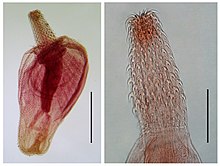Quadrigyridae is the only family within Gyracanthocephala, an order of parasitic worms of class Eoacanthocephala. This family contains two subfamilies, ten genera and about 92 species.

Profilicollis is a genus of acanthocephalan parasites of crustaceans. The status of the genus Profilicollis has been debated, and species placed in this genus were formerly included in the genus Polymorphus. However, research on the morphology of the group and their use of hosts has concluded that Profilicollis and Polymorphus should be regarded as distinct genera, and species previously described as Polymorphus altmani are now referred to as Profilicollis altmani in taxonomic and biological literature. Profilicollis parasites infect decapod crustaceans, usually shore crabs, as intermediate hosts, and use many species of shorebirds as definitive (final) hosts.
Mediorhynchus is a genus of small parasitic spiny-headed worms. Phylogenetic analysis has been conducted on two known species of Mediorhynchus and confirmed the placement along with the related genus Gigantorhynchus in the family Gigantorhynchida. The distinguishing features of this order among archiacanthocephalans is a divided proboscis. This genus contains fifty-eight species that are distributed globally. These worms exclusively parasitize birds by attaching themselves around the cloaca using their hook-covered proboscis. The bird hosts are of different orders.

Moniliformidae is a family of parasitic spiny-headed worms. It is the only family in the Moniliformida order and contains three genera: Australiformis containing a single species, Moniliformis containing eighteen species and Promoniliformis containing a single species. Genetic analysis have determined that the clade is monophyletic despite being distributed globally. These worms primarily parasitize mammals, including humans in the case of Moniliformis moniliformis, and occasionally birds by attaching themselves into the intestinal wall using their hook-covered proboscis. The intermediate hosts are mostly cockroaches. The distinguishing features of this order among archiacanthocephalans is the presence of a cylindrical proboscis with long rows of hooks with posteriorly directed roots and proboscis retractor muscles that pierce both the posterior and ventral end or just posterior end of the receptacle. Infestation with Monoliformida species can cause moniliformiasis, an intestinal condition characterized as causing lesions, intestinal distension, perforated ulcers, enteritis, gastritis, crypt hypertrophy, goblet cell hyperplasia, and blockages.

Oligacanthorhynchida is an order containing a single parasitic worm family, Oligacanthorhynchidae, that attach themselves to the intestinal wall of terrestrial vertebrates.
Centrorhynchidae is a family of parasitic worms. Three species of these thorny-headed worms in the genus Centrorhynchus were found to parasitize birds of prey and owls Slovakia. These hosts include Buteo buteo, Buteo rufinus, Falco tinnunculus, Asio otus, Strix aluco, Strix uralensis and Tyto alba.
Arhythmacanthidae is a family of parasitic worms from the order Echinorhynchida.

Pomphorhynchidae is a family of parasitic worms from the order Echinorhynchida.

Leptorhynchoididae is a family of parasitic worms from the order Echinorhynchida.

Neoechinorhynchidae is a family of parasitic worms from the order Neoechinorhynchida.

Rhadinorhynchidae is a family of parasitic worms from the order Echinorhynchida.
Plagiorhynchidae is a family of parasitic Acanthocephalan worms.
Polymorphus is a genus of parasitic worms from the phylum Acanthocephala. This group uses amphipod crustaceans as intermediate hosts and various birds as final hosts.

Neoandracantha is a genus of parasitic worms from the phylum Acanthocephala. The genus was created in 2017 by Amin & Heckmann for the single species Neoandracantha peruensis.
Rhadinorhynchus is a genus of worms belonging to the family Rhadinorhynchidae.
Andracantha is a genus of parasitic worms belonging to the family Polymorphidae.
Neoechinorhynchus is a genus of parasitic worms belonging to the family Neoechinorhynchidae.

Pseudoacanthocephalus is a genus of parasitic worms belonging to the family Echinorhynchidae.
Pomphorhynchus is a genus of parasitic worms belonging to the family Pomphorhynchidae.

Corynosoma is a genus of parasitic worms belonging to the family Polymorphidae.














